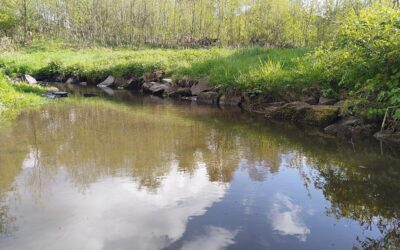Howey caught this walleye just before a cold front moved in, by slowly dragging a jig along the bottom and by knowing what the weather is going to be, you can adjust your presentation in order to catch walleyes. (Larry Myhre Photo)
It’s important that anglers understand the weather reports for the area they plan to fish for walleyes and after talking about it with several Meteorologist and long-time anglers on how the weather affects fishing, the information below should give you a heads up when fishing.
On the earth, there’re only two pressurized systems, air and the water, these conditions are a large part to do with how the walleyes will react, where you’ll find them and how they’re feeding.
Before you hit the water, you need to understand local weather reports to know what’s happening on the days you’ll be fishing.
Before heading out to fish, you need to understand local weather reports to know what’s happening on the days you’ll be fishing.
Weather can affect fishing in several natural ways, as far as how it affects the fish and the way fish behave, in Mother Nature’s world, there are changes, water temperature, wind and Barometric pressure affecting the way fish act.
Understanding barometric pressure is important, as we need to know how the weather and by understanding it, you’ll have better fishing success.
Barometric pressure, the air pressing down on us, the water, the entire earth and very important to how the fish will react as they’ll also feel this pressure.
Both rising and falling barometric pressure will affect underwater creatures, with high-pressure environments a fish is most comfortable, as their bladders aren’t affected.
Fish sense air pressure through their bladders and go deep to relieve the pressure, sensing changes in atmospheric pressure faster than we’re able to.
It’s during high pressure conditions, that the fish go on the bite, feeding heavily, before the front actually comes through.
Fish are cold-blooded, and cannot regulate their body temperature, what this means their body temperature changes with the water temperature.
When water temperatures are cooler, fish will slow down, needing less food to survive, and when the water warms, they’re more active and because of this, will need more food to survive.
When the water temperature drops, during the cooler months, walleyes move closer to shore, and when water temperature rise, the fish begin to move to deeper water and structure.
How are fish affected by different weather fronts, as a cold front comes in, the air pressure will rise, with colder and drier air, with clearing skies and nasty weather and after the cold front goes through, there will be strong wind from the north.
The basic rule is, falling pressure, produces clouds with rain or snow, while with rising pressure, you’ll find that clouds and rain aren’t likely and with rising pressure, clouds and rain aren’t in the picture, with clear skies and decent weather.
Walleyes have very light sensitive eyes and on a sunny warm day, they’ll move deep around underwater structure.
When these conditions happen, as long as there’s some wind movement on the water, what anglers refer to as a” Walleye Chop’” some walleyes can be located in shallower water as the wave action cuts the suns glare.
On sunny bright windy days, if you have a good “Walleye Chop”, walleyes will move into feed under the mud line that’s created by the waves crashing into the shoreline, which carries muddy water back into the lake.
The mud line is created on the top layer of water, with clearer water underneath, allowing the light sensitive walleyes to move in shallow and feed on the baitfish holding there.
If you’re fishing on an overcast day with very little if any breeze, when the water becomes too warm, walleyes move deeper, into deeper water and into the weeds.
The fish can also detect pressure and movement through their lateral line, a sensory system along the fish’s side, allowing them to detect weak water motions and changes in pressure,
When cold fronts move in, fishing will be slow, where you’d swear that there are no fish in the lake or river, unlike a lake, walleyes in the river aren’t affected as bad by these changes as those fish are in a lake.
I’ve found that the best time to fish for walleyes is when the windy conditions create current, cut the light penetration, stirring up the shallow water which in turn, makes the baitfish to become active.
Some of the anglers and fisheries biologist seem to feel that some of the best fishing will be prior, three days before and after a full moon and when this happens, fishing will pick up.
We don’t want to rely completely on the weather, as they’re other conditions that affect the fish and it’s not a 100% accurate all of the time, and you still need to use your locator and GPS.
Understanding weather changes, the cold and warm fronts and how they affect the fish, will help you to be a better angler no matter what the weather is doing.
Gary Howey, Hartington, Nebraska is a former tournament angler, fishing & hunting guide, an award- winning writer, producer, photographer and broadcaster and in 2017 was inducted into the “National Freshwater Fishing Hall of Fame.”
He developed and was the Producer-Host for 23 years of his award winning gary Howey’s Outdoorsmen Adventures television series and the Host of the award-winning Outdoor Adventures radio program carried on Classic Hits 106.3, ESPN Sports Radio 1570 in Southeastern South Dakota, KWYR Country 93 AM and Magic 93 FM in Central South Dakota, As well as on KCHE 92.1 FM in Northwest Iowa. If you’re looking for more outdoor information, check out www.GaryHowey’soutdoors.com , and www.outdoorsmenadventures.com, with more information on these Facebook pages, Gary Howey, Gary E Howey, Outdoor Adventure Radio, Team Outdoorsmen Productions.





0 Comments